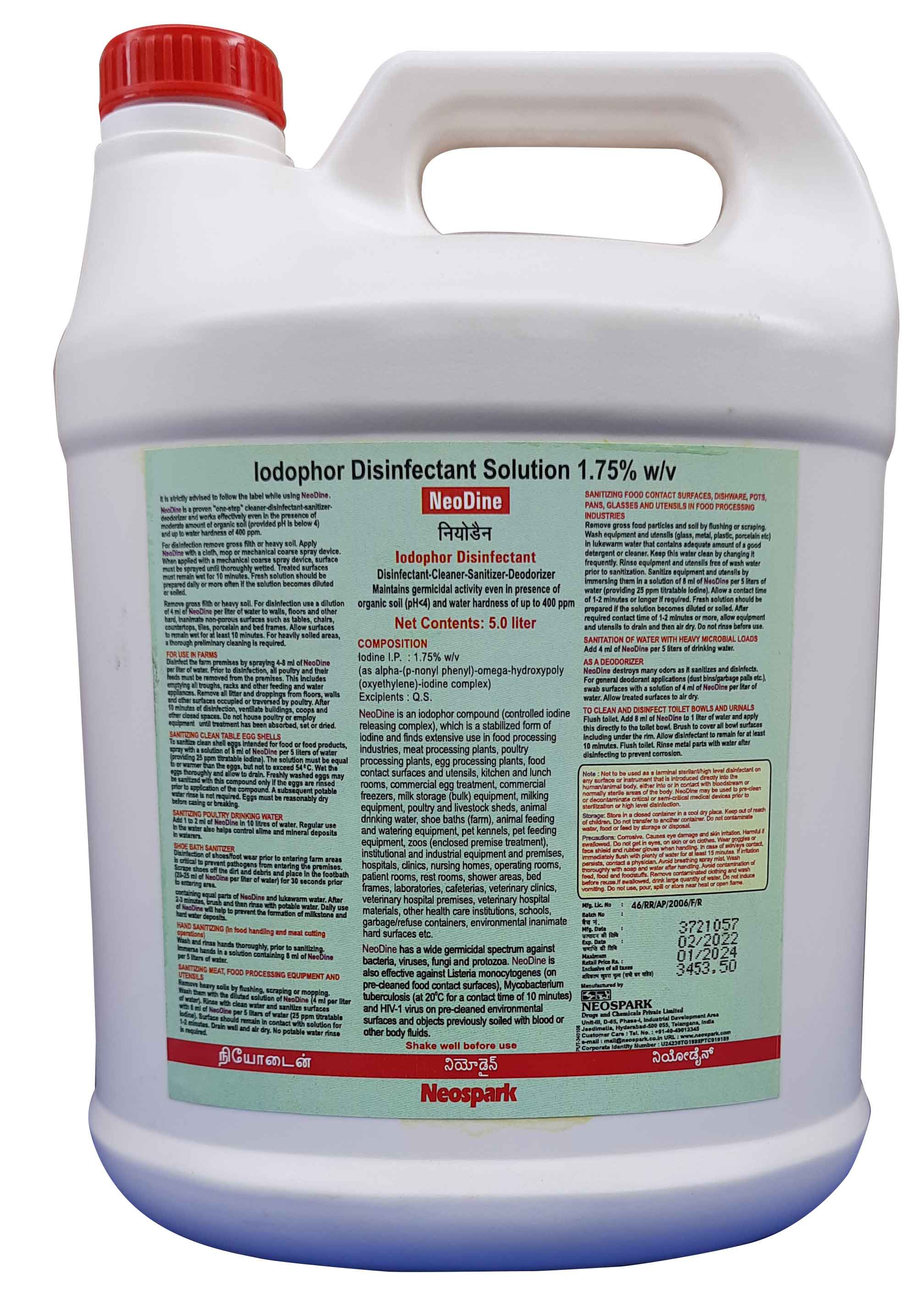Iodine has been in use for several years by virtue of its excellent antimicrobial activity against a wide range of micro-organisms which include bacteria, virus, fungi and protozoa. But elemental iodine as such has few limitations like its low solubility in water, lack of residual germicidal activity, irritant vapors, corrosive nature etc.
Iodophors (controlled iodine releasing complex)
Iodophors carry all the iodine in a complex form, thereby leaving small concentrations of free iodine in the solution. This property helps reduce the drawbacks associated with the presence of elemental iodine i.e. high toxicity, high level of irritation and staining power. Iodophors retain the germicidal action, but not the undesirable properties of iodine.
Advantages of Iodophors over other sanitizers
- Broad-spectrum germicide- bactericidal, virucidal and fungicidal
- Controlled release of iodine ensuring long lasting effect
- It features versatile properties of a cleaner, disinfectant, sanitizer and a deodorizer
- Not affected much by organic matter, water hardness and pH
- No potable water rinse required after sanitizing equipment with NeoDine
- Non-staining, non-corrosive, relatively non-toxic, non-irritating at user dilutions
- Self indicative of effectiveness by color index
- Safe, effective and economical
Composition:
Iodine I.P: 1.75% w/v as alpha-(p-Nonyl Phenyl)-omega-hydroxypoly (oxyethylene)-iodine complex
Mode of action:
Microbicidal property of NeoDine is by the iodination of lipids and oxidation of compounds in the cell membrane and cytoplasm of the microbes leading to disruption of the structural integrity of the organism and thereby killing it.
Dose and methods of use:
To disinfect hard, inanimate non-porous surfaces
For disinfection remove gross filth or heavy soil. For heavily soiled areas, a thorough preliminary cleaning is required. Use a dilution of 4 ml of NeoDine per liter of water to walls, floors and other hard, inanimate non-porous surfaces such as tables, chairs, countertops, tiles, porcelain etc. with a cloth, mop or mechanical coarse spray device. When applied with a mechanical coarse spray device, surface must be sprayed until thoroughly wetted. Treated surfaces must remain wet for 10 minutes.
For Use in Farms
Prior to disinfection, all poultry and their feeds must be removed from the premises. Disinfect the farm premises by spraying 4-8 ml of NeoDine per liter of water. This includes emptying all troughs, racks and other feeding and water appliances. Remove all litter and droppings from floors, walls and other surfaces occupied or traversed by poultry. After 10 minutes of disinfection, ventilate buildings, coops and other closed spaces. Do not house poultry or employ equipment until treatment has been absorbed, set or dried.
Sanitizing Poultry Drinking Water
Add 4 ml of NeoDine per 5 liters of drinking water on a daily basis to fight water-borne pathogens.
To control Wing rot
Wing rot or gangrenous dermatitis is a bacterial infection caused primarily by Clostridium septicum, Clostridium perfringens or Staphylococcus aureus. Occurrence of Wing rot is more likely associated with an IBD outbreak or late coccidiosis. One method of reducing the incidence of Wing rot is the use of NeoDine in the drinking water. One liter of NeoDine is mixed with 6 liters of water to make a stock solution. The stock solution is then given to the birds at a rate of 8 ml per liter of water consumed. The solution is provided to birds once a day for three alternate days. This is most effective when administered immediately after the onset of an outbreak or when an outbreak is expected.
Sanitizing Clean Table Egg Shells
To sanitize clean shell eggs intended for food or food products, spray with a solution of 8 ml of NeoDine per 5 liters of water. The solution must be equal to or warmer than the eggs, but not to exceed 540C. Wet the eggs thoroughly and allow to drain. Freshly washed eggs may be sanitized with this compound only if the eggs are rinsed prior to application of the compound. A subsequent potable water rinse is not required. Eggs must be reasonably dry before casing or breaking.
Shoe Bath Sanitizer
Disinfection of shoes/foot wear prior to entering sheds etc. is critical to prevent pathogens from entering the premises. Scrape shoes off the dirt and debris and place in the footbath (20 - 25 ml of NeoDine per liter of water) for 30 seconds prior to entering area.
Hand Sanitation
Wash hands thoroughly, prior to sanitizing. Immerse hands in a solution containing 8 ml of NeoDine per 5 liters of water.
As a Deodorizer
NeoDine destroys many odors as it sanitizes and disinfects. Swab surfaces with a solution of 4 ml of NeoDine per liter of water. Allow treated surfaces to air dry.
Presentation: 5.0 liters
Precautions:
- Do not use NeoDine for cleaning copper or brass utensils.
- Do not use hot water for making solutions of NeoDine.
- Colour Index: Diluting NeoDine in water gives yellow / amber color, and change of this color indicates that the cleaning property is lost. Make fresh solution again.
